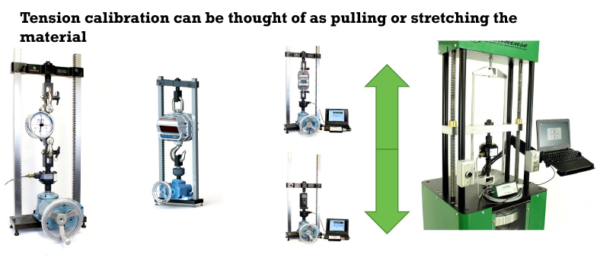Compression and Tension Forces Calibration
In the last Back-to-Basics blog, I covered How a Transducer Measures Force. As I continue to cover basic concepts for beginners, this blog will cover the terms Compression and Tension Forces and how they relate to force calibration.
Compression and Tension Forces: What is a Compression Force Calibration?
When discussing compression forces, we should think about something being compressed or something being squeezed. I like to describe a compression calibration as pushing or squeezing something.

Compression and tension forces (Compression). Above are two examples of a compression setup in a calibrating machine. The machine on the left is compressing both load cells by creating an upward force. The picture on the right is a compression setup in the deadweight machine where a downward force compresses the load cell.
The key to this type of calibration is making sure everything is aligned and that the line of force is as straight as possible. I like to say free from eccentric or side forces. The key to proper alignment is using the right adapters in the calibrating machine, from alignment plugs to top adapters. Morehouse has a technical paper on proper adapters that can be found here.
Compression and Tension Forces: What is a Tension Calibration?
When discussing tension forces, we should think of something being stretched. I like to describe tension calibration as a pull.

Compression and tension forces (tension). Above are multiple examples of tension setups in calibrating machines. The machine on the left is the Morehouse benchtop calibrating machine. A dynamometer is fixed to a stationary beam, and force is generated by pulling on both the load cell and the dynamometer. More examples are shown with different instruments, from crane scales to hand-held force gauges. The picture on the right shows a load cell fixtured for tension calibration in a Morehouse deadweight machine. The load cell is fixtured to the frame, and the weights are applied and hung, which stretches the material. The key to getting great results in tension calibration is also adapters.
The ISO 376 Annex gives excellent guidance on adapters that help keep the line of force pure. It states, “Loading fittings should be designed in such a way that the line of force application is not distorted. As a rule, tensile force transducers should be fitted with two ball nuts, two ball cups, and, if necessary, with two intermediate rings, while compressive force transducers should be fitted with one or two compression pads.”1 Morehouse follows the ISO 376 standard for several of our products. We also design adapters to help technicians and end-users to replicate and reproduce calibration results.
In our next Back-to-Basics blog, I will cover how calibration is different from verification.
Back-to-Basics series:
- Force Calibration and its Importance
- How a Transducer Measures Force
- Compression and Tension Forces Calibration
- Calibration versus Verification
- Measurement Uncertainty
- Load Cell Terminology
- Types of Load Cells
- Load Cell Troubleshooting
- Load Cell Indicator Basics
- Force Measurement Glossary of Terms
If you enjoyed this article, check out our LinkedIn and YouTube channel for more helpful posts and videos.
I take great pride in our knowledgeable team at Morehouse, who will work with you to find the right solution. We have been in business for over a century and focus on being the most recognized name in the force business. That vision comes from educating our customers on what matters most, and having the right discussions relating to force calibration basics so that everyone speaks the same language about Compression and Tension Forces.
Everything we do, we believe in changing how people think about force and torque calibration. We challenge the “just calibrate it” mentality by educating our customers on what matters, and what causes significant errors, and focus on reducing them.
Morehouse makes simple-to-use calibration products. We build fantastic force equipment that is plumb, level, square, rigid, and provide unparalleled calibration service with less than two-week lead times.
Contact us at 717-843-0081 to speak to a live person or email info@mhforce.com for more information.
1 ISO 376 Calibration of Force proving instruments used for the verification of uniaxial testing machines in section A.1
For more information on ISO 376, we have another blog titled Understanding ISO 376 which can is found at here.
#Compression and Tension Forces
#Compression and Tension Force Calibration


